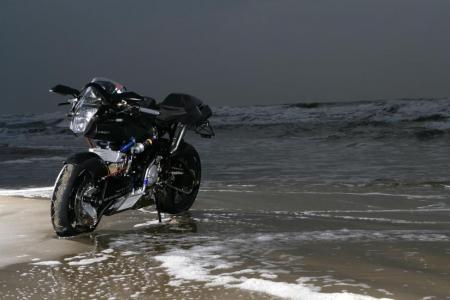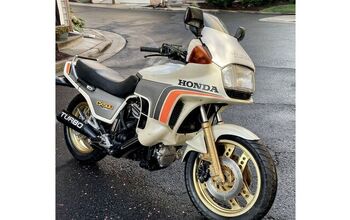2010 Vyrus 987 Review - Motorcycle.com
The new Vyrus 987 flies high even in the rarefied air of ultra sportbikes. It marries a 185-horse Ducati 1198R engine with a hub-center-steered Bimota chassis unlike anything else on the market. Still not cool enough for ya? Then make sure to inspect the chassis made from carbon fiber that helps achieve a claimed curb weight of just 342 pounds! Our Euro correspondent takes a spin on this exotic among exotics! -Ed.
Mama Mia! Just reading the tech specs on this brutally powerful beast of a wonder machine has me choking on the home made meatballs at the Italian corner restaurant. The Vyrus 987 truly can boast about its existence as it’s the world’s best power to weight Superbike hybrid and with the Volumex supercharger it’s the world’s most powerful motorcycle, too. The standard 987 C3 4V produces a staggering 184hp and it only weighs 155 kilos with fluids…
In the autumn of 2009 I and many others received a questionnaire from Vyrus where they asked what I’d want from the then unseen 987. One of the questions was whether I’d prefer a supercharged 211hp version of the 1098R engine or not? “Hell yeah!” was the answer from most people and in February the first one rolled out of the small workshop in Cerasolo Ausa in the Rimini/San Marino border area.
Just to give you an idea of just how exclusive these bikes are I can tell you that Bimota runs a major operation compared to Vyrus. Each bike is built and assembled to order. When you do buy one you’ll be invited over to the workshop to handpick materials and colors from a very exclusive selection of exotic materials should you wish even more customisation than the standard bike. Ascanio Rodorigo himself will walk you through the small warehouse part of the shop taking notes of what you want. No two Vyrus motorcycles are the same. Acquiring a Vyrus adds you to a very exclusive motorcycle club.
Vyrus doesn’t keep test bikes for the press, so when I arrived at the Vyrus workshop I had no expectations to be allowed a ride. Luckily I had my motorcycle kit with me and indeed I was granted a ride on a customer’s 987 C3 4V.
Rodorigo owns Vyrus and he talked me through the test bike where I soon understood that I was granted a road ride on what’s a true race bike. All the 987s come standard with full on MotoGP/WSBK traction control. This means that in addition to control of the different pre programmed traction levels you can add more or less intrusion whilst riding and benefit from launch control - but not the test bike, so no playing with traction control for me.
The standard Pirelli Superbike slicks were in place on a set of 16.5-inch Marvic forged racing wheels rather than the standard 17-inch wheels. The already super powerful Ducati 1198cc R version of the L-Twin had full Zard race exhaust, adding another 10 horsepower to the fun. So there I was about to do a road ride on a full on 194hp race bike with no lights or mirrors and on slicks and it wasn’t even my birthday.
Since the Vyrus is so extremely light even fully fuelled it gives 1.25hp per kilo ready to ride and 0.79hp per kilo including me riding it. I have compared these figures to the Ducati Desmosedici RR, Suzuki Hayabusa and BMW S 1000 RR and whichever way you look at the figures the Vyrus wins the power to weight battle with or without a rider weighing 90 kilos in his kit like I do. Perhaps 55,000 Euro isn’t so bad after all.
| How the Vyrus Stacks Up | ||||||||||||||||||||||||||||
Ascanio Rodorigo started working for Bimota in the 1970s under Massimo Tamburini. He was key putting Pierluigi Marconi’s university thesis into life in the Bimota Tesi 1D. He started the ARP workshop in the 1980s, followed by Vyrus in 2003 | ||||||||||||||||||||||||||||
|
Before I ramble on with more out of this world specifications let me give you some riding impressions. The riding position is very similar to that of Bimota’s Tesi 3D which is the other exclusive hub-steered motorcycle available on the market. The seat’s only got a thin racing padding and along with high foot pegs I am pushed forward into a race bike position. It would be madness not to have some weight over that front wheel anyway. I must admit that I did feel quite big on the Vyrus 987. The 987 is as minimal as designs go to keep the weight down whilst at the same time rich in state of the art technology and handmade parts.
I set off through the Vyrus gates and up into the hills. I’d been given very limited time on the bike, just a teaser really, but I did my best anyway to try and wring out as much as I could from my opportunity. The massive power output is transmitted onto the 190 section Pirelli Diablo Superbike slick rear tyre. Luckily for me it’s a sunny and warm day but there’s nowhere here I can really open up so I resort to first gear to get a feel for the power on a short straight (and empty a gear).
The acceleration is massive and brutal as the big 1198cc Testastretta engine pours out torque and horsepower like nothing else can. It’s oh so over the top on this stretch of road. In many ways that’s exactly what Vyrus is about. Over the top genius engineering, no compromises and no cost spared with the best engine money can buy in Italy. My little test ride was highly illegal, of course, as the bike had no lights, no mirrors, slicks and a noisy exhaust. This didn’t bother me one bit, though. All I was thinking of was the fact that I was in the seat of one of the world’s most powerful and exclusive motorcycles.
I did approach the task with more caution than usual, though as there was no chance for me to really get the slicks warm enough and no way would I want to be responsible for 55,000 Euro of Italian exotica in a ditch. I can argue as much as I like that what’s really spectacular about this 987 is the fairytale power to weight figure, but it’s the hub-steering everybody wonders about. I’ve been lucky enough to have had plenty of both road and track miles on Bimota’s Tesi 3D and the steering feels odd each time I get to ride one. Whilst a conventional fork front end feels feather light to swing from side to side even at standstill, the Vyrus 987 has a rock solid front end feel as if you were to use a super tight steering damper on another bike. Turning radius friendliness for town usage is non existent. The Vyrus 987 is purely built for speed and the amount of stability on this hub-steered front is hard to believe.
The braking forces from the massively powerful Brembo monoblocks gripping from the bottom of the floating discs are separated from the suspension action. Hence you can just stay on those brakes whilst the front swingarm and Ohlins TTX shock handles the bumps independently. On the 987 you can concentrate more on your braking with one handling action (the diving fork) taken away from the thought process. A very light carbon fiber headstock supports the rider’s weight during heavy braking and the minimalist front cowling is also in carbon fiber. A distinctive air-intake tube in carbon fiber sits on the left side of the cowling feeding the large airbox under the fuel tank. The rear suspension is handled by more Ohlins goodness and a chunky aluminium swing arm. Everything is fully adjustable – suspension, steering angle, trail, foot pegs.
Holding the big brute of an engine in place and connecting the two swing arms is the beautiful Omega frame machined from solid blocks of aluminium. There’s very limited room for a big power engine’s radiator on a hub-steered vehicle so Rodorigo and his Vyrus have come up with a special semi-under engine double radiator solution. This keeps the big water-cooled engine in good health whilst ensuring extreme narrowness inherent in L-Twin designs. Again though, the Vyrus 987 is not a road bike for rainy days so best not think at all about all the grime those radiators would collect because it’s not going to happen anyway.
The 1198cc L-Twin breathes out of a set of Zard underseat exhaust silencers with a little one-piece carbon fiber creation on top. With the extreme amount of horsepower and torque available,Vyrus has implemented full racing traction control on the 987. The dash is a well-informed Ducati 1198 connected to the Vyrus spec ECU and electronics package. Vyrus will program one of the three riding modes especially for its customers should one wish. First mode is full on sport, second optional and third Rain. Being a full race system you do have launch control, pit-lane speed limiter and more/less pre-programmed buttons. The pit-lane speed limiter can be programmed to whichever speed you want. Would Sir like a 300km/h cruise control limit for the autobahn or a 50km/h speed camera safety button? It’s all there for you to play with and a bit of a necessity for a motorcycle with a 211 horsepower potential on the racetrack.
Conclusion
“Pura fullya technologica” is a Vyrus motto and translated to English it means “pure crazy technology.” That’s precisely what the Vyrus 987 is. It’s got the world’s most powerful production L-Twin engine from Ducati and then Vyrus tunes it either with the ECU and race exhaust or with an additional Volumex super-charger. I didn’t get to try the supercharged version this time, but even in the most standard setting this bike kicks everybody’s arse, simply the most powerful production bike in the world. It’s as light as the lightest road supermoto and more powerful than the most powerful superbike for the road. Hub-steering will always be special and not many people outside of Ducati’s World Superbike teams have sampled this kind of power. The Vyrus 987 is only for people with lots of money and an advanced level of riding ability.
| Highs: | Lows: | |
| Engine Feather light Built quality Hand-built chassis | Re-defines the word exclusive which is reflected in the price |
More by Tor Sagen


































Comments
Join the conversation